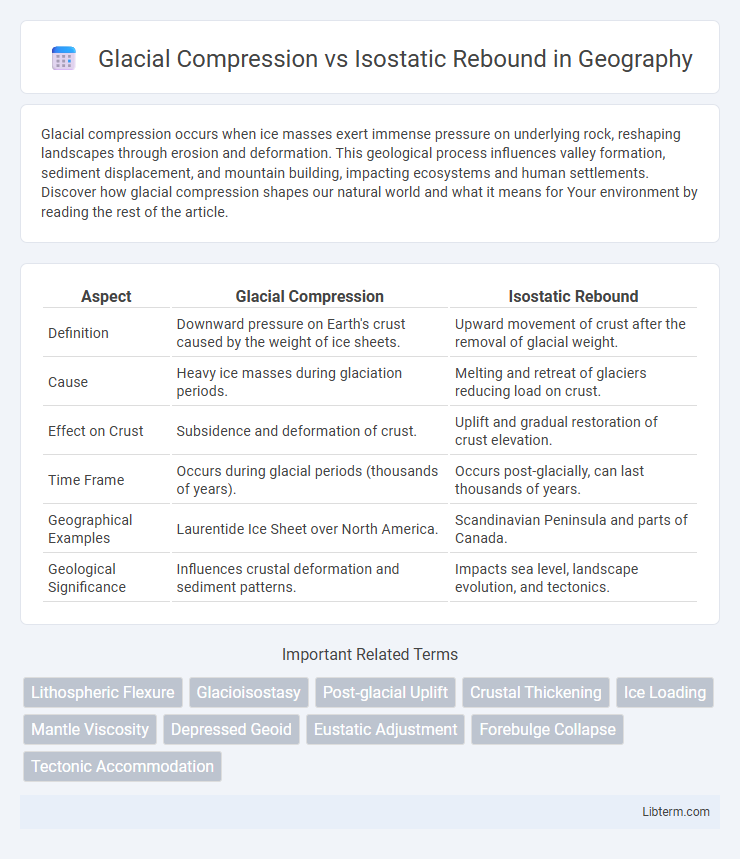Glacial compression occurs when ice masses exert immense pressure on underlying rock, reshaping landscapes through erosion and deformation. This geological process influences valley formation, sediment displacement, and mountain building, impacting ecosystems and human settlements. Discover how glacial compression shapes our natural world and what it means for Your environment by reading the rest of the article.
Table of Comparison
| Aspect | Glacial Compression | Isostatic Rebound |
|---|---|---|
| Definition | Downward pressure on Earth's crust caused by the weight of ice sheets. | Upward movement of crust after the removal of glacial weight. |
| Cause | Heavy ice masses during glaciation periods. | Melting and retreat of glaciers reducing load on crust. |
| Effect on Crust | Subsidence and deformation of crust. | Uplift and gradual restoration of crust elevation. |
| Time Frame | Occurs during glacial periods (thousands of years). | Occurs post-glacially, can last thousands of years. |
| Geographical Examples | Laurentide Ice Sheet over North America. | Scandinavian Peninsula and parts of Canada. |
| Geological Significance | Influences crustal deformation and sediment patterns. | Impacts sea level, landscape evolution, and tectonics. |
Introduction to Glacial Compression and Isostatic Rebound
Glacial compression occurs when massive ice sheets exert immense pressure on the Earth's crust, causing it to deform and sink. Isostatic rebound is the gradual uplift of the crust that follows when the ice melts and the pressure is released, allowing the land to rise back toward its original position. These processes are critical in understanding post-glacial landscape changes and have significant impacts on sea levels and crustal dynamics.
The Science Behind Glacial Compression
Glacial compression occurs when massive ice sheets exert tremendous pressure on the Earth's crust, causing it to deform and sink into the mantle due to the weight of the overlying ice. This process significantly alters the lithosphere's rigidity and stress distribution, leading to subsidence in glaciated regions. Understanding glacial compression is essential for modeling Earth's crustal response during glacial cycles and interpreting post-glacial land uplift phenomena.
Mechanisms of Isostatic Rebound Explained
Isostatic rebound occurs when the Earth's lithosphere, previously compressed by massive glacial ice sheets, lifts and returns to its original position as the ice melts and the weight is removed. This process involves the asthenosphere flowing back beneath the lithosphere to restore equilibrium, driven by the buoyancy forces acting on the Earth's crust. Glacial compression causes the crust to flex downward, while isostatic rebound is the slow vertical rise resulting from the gradual mantle flow adjusting to the reduced surface load.
Historical Evidence from Glacial Landforms
Glacial compression during ice ages caused significant deformation of the Earth's crust, evident from extensive moraines, drumlins, and striations found in formerly glaciated regions. Isostatic rebound is demonstrated by raised beaches, raised shorelines, and tilted sediment layers in areas like Fennoscandia and the Great Lakes, indicating the crust's gradual uplift post-glaciation. These glacial landforms provide crucial historical evidence of the dynamic interplay between ice mass loading and crustal response across millennia.
Measuring Crustal Response to Ice Loads
Glacial compression occurs when massive ice sheets exert downward pressure on the Earth's crust, causing it to deform and sink. Isostatic rebound refers to the gradual uplift of the crust once the ice load is removed, restoring equilibrium. Measuring crustal response to ice loads involves GPS and satellite altimetry data to track vertical land movement and gravity anomalies, providing critical insights into mantle viscosity and lithosphere elasticity.
Global Examples of Isostatic Adjustment
Isostatic rebound, also known as post-glacial rebound, occurs as Earth's crust rises after the melting of massive ice sheets, exemplified by the rapid uplift observed in Scandinavia and Canada, where the land has risen by up to 300 meters since the last Ice Age. In contrast, glacial compression refers to the downward pressure exerted by ice masses on the lithosphere, causing subsidence beneath glaciers such as those in Antarctica and Greenland. The ongoing isostatic adjustment in regions like Hudson Bay and the Fennoscandian Shield is critical for understanding sea-level changes and crustal deformation processes driven by glacial-interglacial cycles.
Impacts on Sea Level and Coastlines
Glacial compression, caused by the immense weight of ice sheets, depresses the Earth's crust leading to lowered land elevations and displacement of ocean water, which can initially contribute to sea level rise in adjacent areas. Isostatic rebound occurs when glaciers melt and the previously compressed crust gradually uplifts, causing relative local sea level to fall and reshaping coastlines through land emergence and altered tidal patterns. These processes significantly influence regional sea level changes and coastal morphology, affecting habitats, erosion rates, and human settlements along shorelines.
Human and Environmental Implications
Glacial compression causes land to sink under the immense weight of ice sheets, leading to altered ecosystems and increased flood risk in coastal human settlements. Isostatic rebound occurs as the land slowly rises once the ice melts, potentially causing changes in groundwater flow and infrastructure stability in affected regions. These processes impact human activities by influencing sea levels, habitat distribution, and geotechnical challenges in formerly glaciated areas.
Technological Advances in Studying Earth’s Movements
Technological advances such as satellite geodesy, including GPS and InSAR, have revolutionized the study of glacial compression and isostatic rebound by enabling precise measurements of ground deformation over time. High-resolution gravity field data from missions like GRACE provide crucial insights into mass redistribution caused by ice sheet dynamics. These innovations enhance the understanding of Earth's lithospheric response to glacial loading and unloading processes with unprecedented spatial and temporal accuracy.
Future Projections and Ongoing Research
Future projections of glacial compression and isostatic rebound involve advanced modeling that incorporates satellite data and climate change scenarios to predict land elevation changes over the next century. Ongoing research emphasizes the interaction between melting ice sheets and mantle flow dynamics, improving the accuracy of forecasts for regions such as Greenland and Antarctica. These efforts are critical for assessing sea-level rise impacts and guiding coastal adaptation strategies worldwide.
Glacial Compression Infographic

 libterm.com
libterm.com